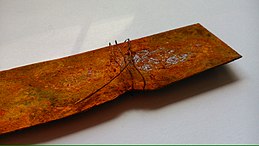Iron oxide

An iron oxide is a
Iron oxides and oxyhydroxides are widespread in nature and play an important role in many geological and biological processes. They are used as iron ores, pigments, catalysts, and in thermite, and occur in hemoglobin. Iron oxides are inexpensive and durable pigments in paints, coatings and colored concretes. Colors commonly available are in the "earthy" end of the yellow/orange/red/brown/black range. When used as a food coloring, it has E number E172.
Stoichiometries


Iron oxides feature as
- Oxides of FeII
- FeO: iron(II) oxide, wüstite
- Mixed oxides of FeII and FeIII
- Oxides of FeIII
- Fe2O3: iron(III) oxide
- α-Fe2O3: alpha phase, hematite
- β-Fe2O3: beta phase
- γ-Fe2O3: gamma phase, maghemite
- ε-Fe2O3: epsilon phase
- Fe2O3: iron(III) oxide
Thermal expansion
| Iron oxide | CTE (× 10−6 °C−1) |
|---|---|
| Fe2O3 | 14.9[6] |
| Fe3O4 | >9.2[6] |
| FeO | 12.1[6] |
Oxide-hydroxides
- goethite (α-FeOOH)
- akaganéite(β-FeOOH)
- lepidocrocite (γ-FeOOH)
- feroxyhyte (δ-FeOOH)
- ferrihydrite (Fe5HO8 · 4 H2O approx., or 5 Fe2O3 · 9 H2O, better recast as FeOOH · 0.4 H2O)
- high-pressure pyrite-structured FeOOH.[7] Once dehydration is triggered, this phase may form FeO2Hx (0 < x < 1).[8]
- green rust (FeIII
xFeII
yOH3x + y − z (A−)z where A− is Cl− or 0.5 SO2−4)
Reactions
In blast furnaces and related factories, iron oxides are converted to the metal. Typical reducing agents are various forms of carbon. A representative reaction starts with ferric oxide:[9]
- 2 Fe2O3 + 3 C → 4 Fe + 3 CO2
In nature
Iron is stored in many organisms in the form of ferritin, which is a ferrous oxide encased in a solubilizing protein sheath.[10]
Species of
Uses
Almost all iron ores are oxides, so in that sense these materials are important precursors to iron metal and its many alloys.
Iron oxides are important pigments, coming in a variety of colors (black, red, yellow). Among their many advantages, they are inexpensive, strongly colored, and nontoxic.[12]
Magnetite is a component of magnetic recording tapes.
See also
- Great Oxidation Event
- Iron cycle
- Iron oxide nanoparticle
- Limonite
- List of inorganic pigments
- Iron(II) hydroxide
References
- ISBN 978-3-527-30274-1.
- PMID 21969537.
- PMID 26601196.
- ^ PMID 26864300.
- S2CID 54496448.
- ^ ISSN 0360-3199.
- S2CID 205257075.
- PMID 28143928.
- ISBN 978-0-08-037941-8.
- PMID 25418839.
- PMID 17644630.
- ISBN 978-3527306732.
